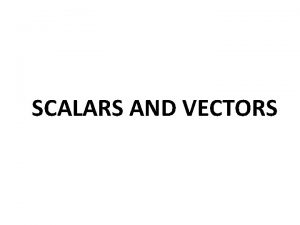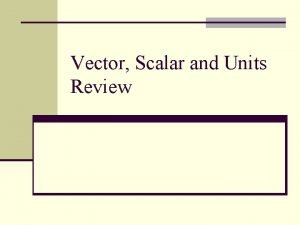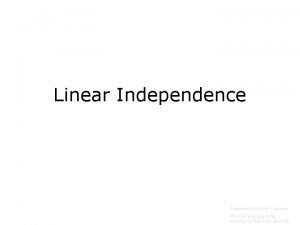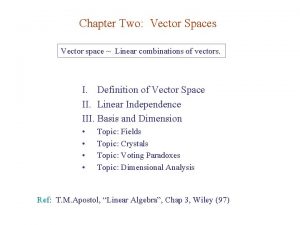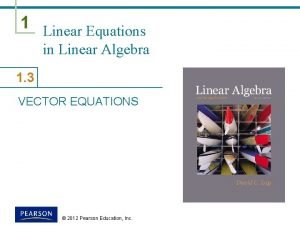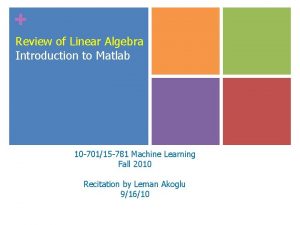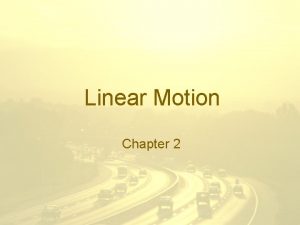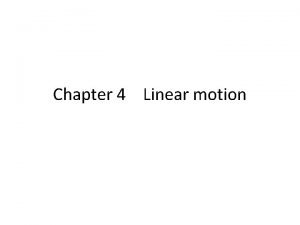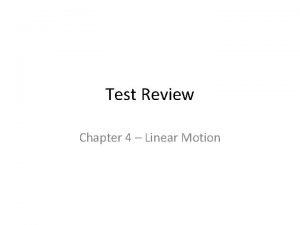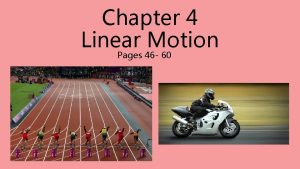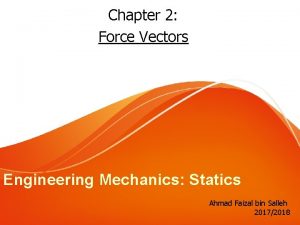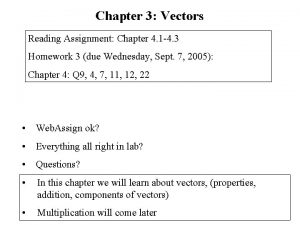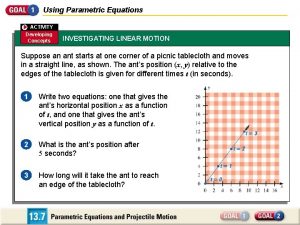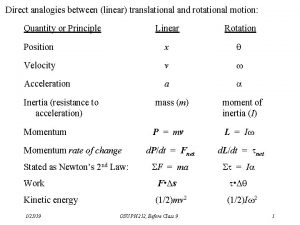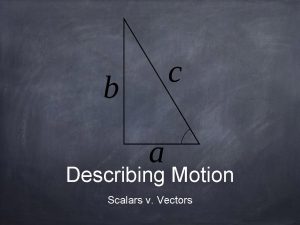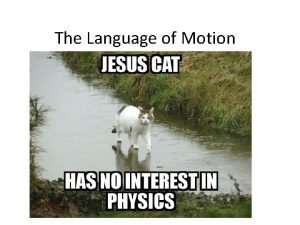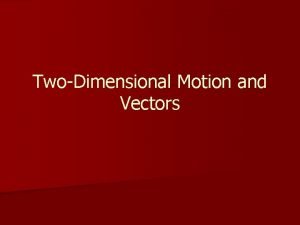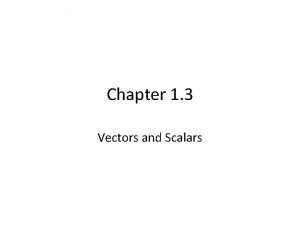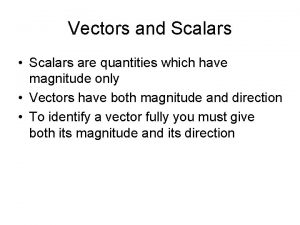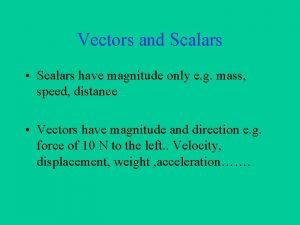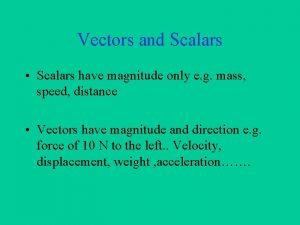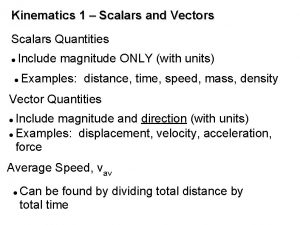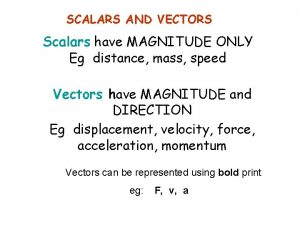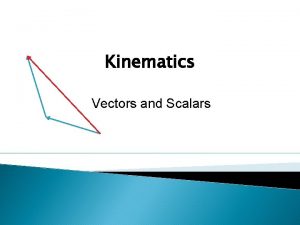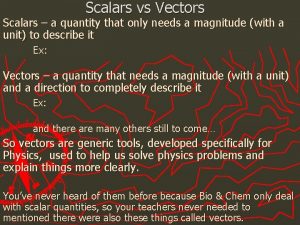Linear Motion Chapter 2 Vectors vs Scalars Scalars




































- Slides: 36

Linear Motion Chapter 2

Vectors vs Scalars • Scalars are quantities that have a magnitude, or numeric value which represents a size i. e. 14 m or 76 mph. • Vectors are quantities which have a magnitude and a direction, for instance 12 m to the right or 32 mph east.

Describing how far you’ve gone • Distance d • Scalar • Standard units are meters • A measure of how far you have moved with respect to you (what a pedometer would measure) • Displacement d • Vector • Standard units are meters accompanied by direction. • A measure of how far you are with respect to where you started (or change in position).

Distance vs Displacement • The person, according to a pedometer has walked a total of 12 m. That is the distance traveled. • The person walking starts where she stops, so her displacement is zero.

Measuring how fast you are going • Speed v • Scalar • Standard unit is m/s • Velocity v • Vector • Standard unit is m/s, plus direction

Velocity and Speed • If it take the person 4 seconds to walk around the square, what is her average speed and average velocity? • For speed, d=12 m and t=4 s, so v=3 m/s • For velocity, d=0 and t=4 s, so v=0 m/s

Practice Problem • A boy takes a road trip from Philadelphia to Pittsburgh. The distance between the two cities is 300 km. He travels the first 100 km at a speed of 35 m/s and the last 200 km at 40 m/s. What is his average speed?

Practice Problem • A boy takes a road trip from Philadelphia to Pittsburgh. The distance between the two cities is 300 km. He travels the first 100 km at a speed of 35 m/s and the last 200 km at 40 m/s. What is his average speed?

Different types of velocity and speed • Average velocity/speed • A value summarizing the average of the entire trip. • All that’s needed is total displacement/distance and total time. • Instantaneous velocity • A value that summarizes the velocity or speed of something at a given instant in time. • What the speedometer in you car reads. • Can change from moment to moment.

Acceleration • delta. • Means “change in” and is calculated by subtracting the initial value from the final value. • Change in velocity over time. • Either hitting the gas or hitting the break counts as acceleration. • Units are m/s 2

Using linear motion equations • We always assume that acceleration is constant. • We use vector quantities, not scalar quantities. • We always use instantaneous velocities, not average velocities • Direction of a vector is indicated by sign. Incorrect use of signs will result in incorrect answers.

Practice Problem A car going 15 m/s accelerates at 5 m/s 2 for 3. 8 s. How fast is it going at the end of the acceleration? First step is identifying the variables in the equation and listing them.

Practice Problem A car going 15 m/s accelerates at 5 m/s 2 for 3. 8 s. How fast is it going at the end of the acceleration? t=3. 8 s vi=15 m/s a=5 m/s 2 vf=?

Practice Problem 2 • A penguin slides down a glacier starting from rest, and accelerates at a rate of 7. 6 m/s 2. If it reaches the bottom of the hill going 15 m/s, how long does it take to get to the bottom?

Practice Problem 2 • A penguin slides down a glacier starting from rest, and accelerates at a rate of 7. 6 m/s 2. If it reaches the bottom of the hill going 15 m/s, how long does it take to get to the bottom?

Equation for displacement

Practice Problems • A car slows from 45 m/s to 30 m/s over 6. 2 s. How far does it travel in that time? • A cyclist speeds up from his 8. 45 m/s pace. As he accelerates, he goes 325 m in 30 s. What is his final velocity?

Equation that doesn’t require vf

Practice Problems A ball rolling up a hill accelerates at – 5. 6 m/s 2 for 6. 3 s. If it is rolling at 50 m/s initially, how far has it rolled? If a car decelerates at a rate of – 4. 64 m/s 2 and it travels 162 m in 3 s, how fast was it going initially?

An equation not needing t

A bowling ball is thrown at a speed of 6. 8 m/s. By the time it hits the pins 63 m away, it is going 5. 2 m/s. What is the acceleration?

The Big 4

Gravity • Gravity causes an acceleration. • All objects have the same acceleration due to gravity. • Differences in falling speed/acceleration are due to air resistance, not differences in gravity. • g=-9. 8 m/s 2 • When analyzing a falling object, consider final velocity before the object hits the grounds.

Problem Solving Steps • Identify givens in a problem and write them down. • Determine what is being asked for and write down with a questions mark. • Select an equation that uses the variables (known and unknown) you are dealing with and nothing else. • Solve the selected equation for the unknown. • Fill in the known values and solve equation

Hidden Variables • Objects falling through space can be assumed to accelerate at a rate of – 9. 8 m/s 2. • Starting from rest corresponds to a vi=0 • A change in direction indicates that at some point v=0. • Dropped objects have no initial velocity.

Practice Problem • A ball is thrown upward at a speed of 5 m/s. How far has it traveled when it reaches the top of its path and how long does it take to get there? vi=5 m/s d=? vf=0 m/s t=? a=g=-9. 8 m/s 2

A plane slows on a runway from 207 km/hr to 35 km/hr in about 527 m. a. What is its acceleration? b. How long does it take?

An onion falls off an 84 m high cliff. How long does it take him to hit the ground?

An onion is thrown off of the same cliff at 9. 5 m/s straight up. How long does it take him to hit the ground?

A train engineer notices a cow on the track when he is going 40. 7 m/s. If he can decelerate at a rate of -1. 4 m/s 2 and the cow is 500 m away, will he be able to stop in time to avoid hitting the cow?

Displacement (Position) vs. Time Graphs • Position, or displacement can be determined simply by reading the graph. • Velocity is determined by the slope of the graph (slope equation will give units of m/s). • If looking for a slope at a specific point (i. e. 4 s) determine the slope of the entire line pointing in the same direction. That will be the same as the slope of a specific point. What is the velocity of the object at 4 seconds?

Velocity vs. Time Graphs • Velocity is determined by reading the graph. • Acceleration is determined by reading the slope of the graph (slope equation will give units of m/s 2).

Velocity vs. Time Graphs • Displacement is found using area between the curve and the x axis. This area is referred to as the area under the curve (finding area will yield units of m). • Areas above the x axis are considered positive. Those underneath the x axis are considered negative. • Break areas into triangles (A=1/2 bh), rectangles (A=bh), and trapezoids (A=1/2[b 1+ b 2]h).

Velocity vs. Time Graphs • What is the acceleration of the object at 6 s? • What is the displacement of the object at 4 s? • What is the displacement of the object from 3 s to 12 s?

Homework • Problems Required: 3, 9, 10, 12, 13, 17, 20, 22, 28, 30, 31, 33, 34, 38, 41, 45, 47, 49, 54 Additional: 1, 2, 4 -7, 11, 14 -16, 18, 19, 21, 23, 29, 35, 39, 42 -44, 46, 48, 55 -57, 60 • Graph Practice Sheet

• Graph packet • Graph worksheets from old book • Investigations 1, 2, 3 computer labs
 Vectors and scalars in physics
Vectors and scalars in physics Vector quantity formula
Vector quantity formula Difference between scalar and vector
Difference between scalar and vector Entropy is scalar or vector
Entropy is scalar or vector Multiplying or dividing vectors by scalars results in:
Multiplying or dividing vectors by scalars results in: Lesson plan on vectors and scalars
Lesson plan on vectors and scalars Vectors vs scalars
Vectors vs scalars In her physics lab melanie rolls
In her physics lab melanie rolls Prasanna balaprakash
Prasanna balaprakash Linear independence of vectors
Linear independence of vectors Vector space
Vector space Linearly dependent and independent vectors
Linearly dependent and independent vectors How to do linear combination
How to do linear combination Basic concepts of matrices
Basic concepts of matrices Chapter 2 motion section 1 describing motion answer key
Chapter 2 motion section 1 describing motion answer key Describing and measuring motion
Describing and measuring motion Section 1 describing motion
Section 1 describing motion Conceptual physics chapter 3 linear motion
Conceptual physics chapter 3 linear motion Chapter 2 linear motion
Chapter 2 linear motion Chapter 4 linear motion
Chapter 4 linear motion Linear motion in class test review answers
Linear motion in class test review answers Chapter 4 linear motion
Chapter 4 linear motion Force vector engineering mechanics
Force vector engineering mechanics Chapter 3 vectors worksheets
Chapter 3 vectors worksheets A 100 lb weight hangs from two wires
A 100 lb weight hangs from two wires Dot product
Dot product What is the name of the quantity represented as i^?
What is the name of the quantity represented as i^? What is active rom
What is active rom Harmonic equation
Harmonic equation An object in motion stays in motion
An object in motion stays in motion Concept 1 notes describing motion
Concept 1 notes describing motion Section 1 describing motion
Section 1 describing motion Chapter 2 study guide physics
Chapter 2 study guide physics In a pumpkin tossing contest in morton illinois
In a pumpkin tossing contest in morton illinois Uniform linear motion examples
Uniform linear motion examples The drive which is used for metal cutting
The drive which is used for metal cutting Analogy between linear and rotational motion
Analogy between linear and rotational motion



